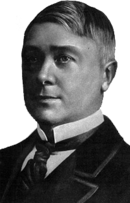- Pelléas and Mélisande
-
For other uses, see Pelleas and Melisande (disambiguation).
Pelléas and Mélisande Written by Maurice Maeterlinck Characters Arkël, king of Allemonde
Geneviève, mother of Pelléas and Golaud
Pelléas, grandson of Arkël
Golaud, grandson of Arkël
Mélisande
Little Yniold, son of Golaud (by a former marriage)
Physician
Porter
Servants
BeggarsDate premiered 17 May 1893 Genre Symbolism Pelléas and Mélisande (French: Pelléas et Mélisande) is a Symbolist play by Maurice Maeterlinck about the forbidden, doomed love of the title characters. It was first performed in 1893.
The work was very popular. It was adapted as an opera by the same name and set to music by the composer Claude Debussy, who had the first performance in Paris in 1902. The play inspired other contemporary composers, for instance, Gabriel Fauré, Arnold Schoenberg, and Jean Sibelius.
Contents
Synopsis
Golaud discovers Mélisande by a stream in the woods. She has lost her crown in the water but does not wish to retrieve it. They marry, and she instantly wins the favor of Arkël, Golaud's grandfather and king of Allemonde, who is ill. She falls in love with Pelléas, Golaud's brother. They meet by the fountain, where Mélisande loses her wedding ring. Golaud grows suspicious of the lovers, has his son Yniold spy on them, and discovers them caressing, whereupon he kills Pelléas and wounds Mélisande. She later dies after giving birth to an abnormally small girl.
Themes
The main theme is the cycle of creation and destruction. Pelléas and Mélisande form a bond of love, which, step by step, cascades to its fatal end. Maeterlinck had studied Pythagorean metaphysics and believed that human action was guided by Eros (love/sterility) and Anteros (revenge/chaos). The juxtaposition of these two forces brings about a never-ending cycle of calm followed by discord and then change. Pelléas and Mélisande are so much in love that they disregard the value of marriage, provoking the ire of Anteros, who brings revenge and death, which restores order.
Several factors indicate the initial reign of Eros in the play. There is a famine in Arkël's kingdom, indicating that the time for change is nigh. The servants complain that they cannot thoroughly wash the dirt from the steps of the castle.[1]
Water is a key element in the play. It appears in several forms throughout the work: Golaud finds her by a stream, Mélisande arrived in the kingdom by sea, she loses her wedding ring in a fountain, Golaud and Pelléas discover foul-smelling waters under Arkël's castle, Mélisande is often seen crying and mentions her tears several times. Moreover, most of the characters' names contain liquid consonants: Pelléas, Mélisande, Arkël, Golaud, Yniold. She appears to be related to the mythical figure Mélusine in French folklore.
Pelléas and Mélisande can be considered a fairy tale.
Premiere
Pelléas and Mélisande premiered on 17 May 1893 at the Bouffes-Parisiens under the direction of Aurélien Lugné-Poe. Lugné-Poe, possibly taking inspiration from The Nabis, an avant garde group of Symbolist painters, used very little lighting on the stage. He also removed the footlights. He placed a gauze veil across the stage, giving the performance a dreamy and otherworldly effect. This was the antithesis to the realism popular in French theatre at the time.
Maeterlinck was so nervous on the night of the premiere that he did not attend. Critics derided the performance, but Maeterlinck's peers received it more positively. Octave Mirbeau, to whom Maeterlinck dedicated his play, was impressed with the work, which stimulated a new direction in stage design and theatre performance.[2]
In music
Main article: Pelleas and Melisande (disambiguation)The play has been the basis of several pieces of music. Perhaps the best known is the opera (1902) of the same name by Claude Debussy. In 1898, Gabriel Fauré had written incidental music for performances of the play in London and asked Charles Koechlin to orchestrate it, from which he later extracted a suite. The story inspired Arnold Schoenberg's early symphonic poem Pelleas und Melisande of 1902-03. Jean Sibelius also wrote incidental music for it in 1905; the section, "At the castle gate," has found fame as the signature music of the BBC The Sky at Night programme.
References
The works of Maurice Maeterlinck Plays Princess Maleine • Intruder • The Blind • The Seven Princesses • Pelléas and Mélisande • Alladine and Palomides • Interior • The Death of Tintagiles • Aglavaine and Sélysette • Ariane and Bluebeard • Sister Beatrice • Monna Vanna • Joyzelle • The Blue Bird • Mary Magdelene • The Miracle of St. Anthony • The Mayor of Stilmonde • The Betrothal • The Cloud That Lifted • The Power of the Dead • Berniquel • Marie-Victoire • Joan of Arc • Father Setubal • The Three Justiciaries • The Last Judgment
Poems Hothouses • Twelve SongsShort stories The Massacre of the Innocents • OnirologyBallet The Dance of the StarsEssays & prose The Treasure of the Humble • Wisdom and Destiny • The Life of the Bee • The Intelligence of Flowers • The Life of the Termite • Blue BubblesCategories:- 1893 plays
- Plays by Maurice Maeterlinck
Wikimedia Foundation. 2010.
